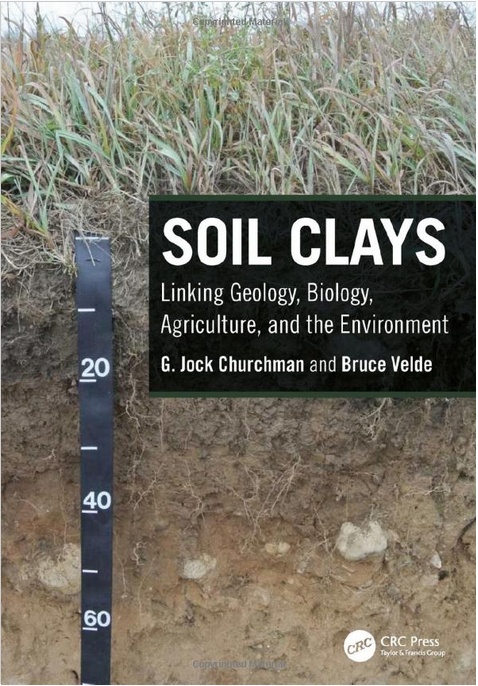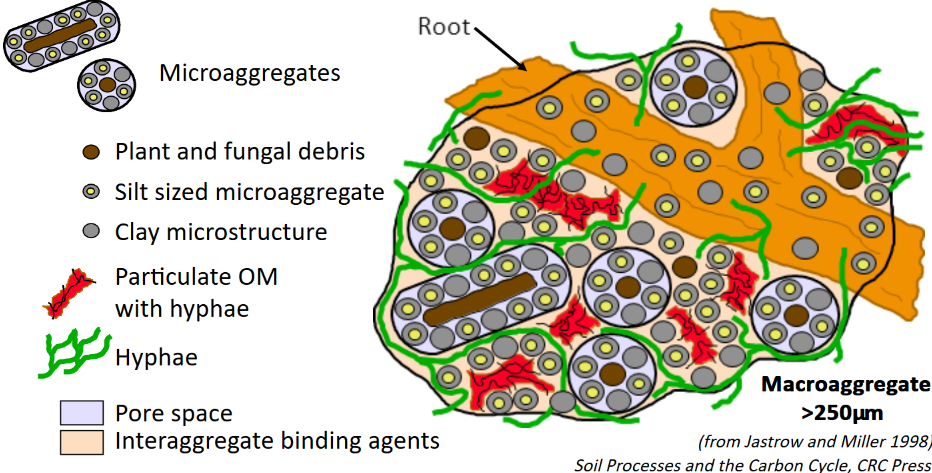Soil clays
What can we gain from knowledge of soil clays? This book seeks to answer the question and to impart that knowledge. Targeted towards soil or environmental scientists, agronomists and/or land planners, Soil Clays: Linking Geology, Biology, Agriculture and the Environment is a useful reference book for understanding more about the critical zone that sustains terrestrial life on Earth.
|
The number of humans on Earth has increased immensely during the last century and will continue growing for the foreseeable future. To feed the world’s population, it has been estimated that soils need to provide 50% more food. Not only this, soils provide physical support and nutrients for plants, mitigate flood waters, stimulate the breakdown of organic matter and wastes, store carbon dioxide, and are a habitat for micro- and macrofauna and the microorganisms that provide element biogeochemical cycling. But, why clays? The central proposition of this book is that “major properties of soils can be reduced in a large part to those of their clay minerals”. To understand soils, we need to understand soil clays.
The book describes soils as weathered from rock, supporting (or capable of supporting) life, porous, and forming horizons; clays as secondary inorganic materials less than 2 µm in size. |
Although rocks have been weathering since the atmosphere became oxygenated 2.4 billion years ago, soils only formed 440 million years ago when vascular land plants with deep roots evolved, contributing to physical, chemical, and biological weathering.
Chapter 2 introduces the mineralogy of sheet silicate minerals, assuming some prior knowledge, and describes how cation substitution, interlayer anions and vacancies arise and lead to charge deficiencies, influencing chemical behaviour and thus the availability of nutrients. The chapter would benefit from a list of general chemical formulae for the different mineral groups, and a glossary.
Of most interest to environmental chemists is Chapter 6 – chemistry of alteration by weathering. Here, interactions are described between primary minerals and protons derived from rainwater and/or electrons derived from dissolved oxygen. These cause weathering by mineral change, dissolution, diffusion, ion exchange, and oxidation. Chemically stable aluminosilicate minerals rapidly precipitate from solution, and are therefore common solid-phase products. In contrast, ionic alkali metals and alkaline earth metals are more soluble. Chapter 7 describes the mechanisms of clay formation (e.g. crystal growth and thermodynamic considerations). Chapter 8 is an excellent reference source for the nature and origin of secondary clay minerals, while Chapter 9 covers the effect of different climates on soil clay formation.
Chapter 10 reviews the literature on the interactions between soil clay minerals and organic matter, which react by selective adsorption and surface polymerisation. Importantly for carbon turnover dynamics, clays can sequester organic matter away from soil organisms that would otherwise consume it and release it back to the atmosphere as carbon dioxide. Chapter 10 also covers the concepts of soil micro- and macroaggregates (Figure 1). Microaggregates are poorly described as “the fundamental units of soils”. They are associations of organic matter with phyllosilicate and oxide minerals, which are a few µm in size, and with varying compositions and shapes. Given their importance, it was disappointing the book did not contain a good diagram, such as Figure 1.
Chapter 2 introduces the mineralogy of sheet silicate minerals, assuming some prior knowledge, and describes how cation substitution, interlayer anions and vacancies arise and lead to charge deficiencies, influencing chemical behaviour and thus the availability of nutrients. The chapter would benefit from a list of general chemical formulae for the different mineral groups, and a glossary.
Of most interest to environmental chemists is Chapter 6 – chemistry of alteration by weathering. Here, interactions are described between primary minerals and protons derived from rainwater and/or electrons derived from dissolved oxygen. These cause weathering by mineral change, dissolution, diffusion, ion exchange, and oxidation. Chemically stable aluminosilicate minerals rapidly precipitate from solution, and are therefore common solid-phase products. In contrast, ionic alkali metals and alkaline earth metals are more soluble. Chapter 7 describes the mechanisms of clay formation (e.g. crystal growth and thermodynamic considerations). Chapter 8 is an excellent reference source for the nature and origin of secondary clay minerals, while Chapter 9 covers the effect of different climates on soil clay formation.
Chapter 10 reviews the literature on the interactions between soil clay minerals and organic matter, which react by selective adsorption and surface polymerisation. Importantly for carbon turnover dynamics, clays can sequester organic matter away from soil organisms that would otherwise consume it and release it back to the atmosphere as carbon dioxide. Chapter 10 also covers the concepts of soil micro- and macroaggregates (Figure 1). Microaggregates are poorly described as “the fundamental units of soils”. They are associations of organic matter with phyllosilicate and oxide minerals, which are a few µm in size, and with varying compositions and shapes. Given their importance, it was disappointing the book did not contain a good diagram, such as Figure 1.
Chapter 11 and 12 review how soil clays can be extracted and identified, and are better suited to specialists. They could be improved by outlining advantages and disadvantages of techniques.
The effects of surface charge, surface area and particle size are covered in Chapter 13. My understanding is that the large surface area and strongly charged surfaces of clays explain why they are so reactive. Placing this chapter towards the end of the book is therefore out of place.
If you were still wondering, why clays matter, then Chapter 14 outlines their role in agriculture, environment, and society. This includes how soil clays support plant nutrition, hold water, impact buildings by shrinking or swelling, and sequester carbon. Pollutant mitigation by clays and medicinal clays is included. Given their importance, more details would have been useful. The final chapter summarises the entire book in just 12 pages. If you have limited time, this is a great place to start.
In summary, clays are sometimes forgotten or not considered because they are too small, thought to be insignificant, or too difficult to understand. This book argues the case for clays, explaining what they are and the mechanisms for their chemical reactivity. It is a useful reference material that unifies all aspects of soil clays.
References
Churchman, G. J. and Velde, B., 2019. Soil Clays: Linking Geology, Biology, Agriculture and the Environment. 1st Edition. CRC Press, Boca Raton, FL. ISBN: 9781498770057.
Jastrow, J. D. and Miller, R. M., 1998. Soil Aggregate Stabilization and Carbon Sequestration: Feedbacks through Organomineral Associations. In Stewart, B., Lal, R., Kimble, J., Follett, R., Stewart, B. (Eds.). Soil Processes and the Carbon Cycle. CRC Press, Boca Raton, FL. ISBN: 9780203739273.
The effects of surface charge, surface area and particle size are covered in Chapter 13. My understanding is that the large surface area and strongly charged surfaces of clays explain why they are so reactive. Placing this chapter towards the end of the book is therefore out of place.
If you were still wondering, why clays matter, then Chapter 14 outlines their role in agriculture, environment, and society. This includes how soil clays support plant nutrition, hold water, impact buildings by shrinking or swelling, and sequester carbon. Pollutant mitigation by clays and medicinal clays is included. Given their importance, more details would have been useful. The final chapter summarises the entire book in just 12 pages. If you have limited time, this is a great place to start.
In summary, clays are sometimes forgotten or not considered because they are too small, thought to be insignificant, or too difficult to understand. This book argues the case for clays, explaining what they are and the mechanisms for their chemical reactivity. It is a useful reference material that unifies all aspects of soil clays.
References
Churchman, G. J. and Velde, B., 2019. Soil Clays: Linking Geology, Biology, Agriculture and the Environment. 1st Edition. CRC Press, Boca Raton, FL. ISBN: 9781498770057.
Jastrow, J. D. and Miller, R. M., 1998. Soil Aggregate Stabilization and Carbon Sequestration: Feedbacks through Organomineral Associations. In Stewart, B., Lal, R., Kimble, J., Follett, R., Stewart, B. (Eds.). Soil Processes and the Carbon Cycle. CRC Press, Boca Raton, FL. ISBN: 9780203739273.



